
Postage Stamps of the United States - 1913
Politics
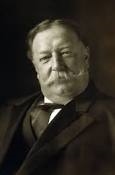
President
Jan. 1 - Mar. 4: William Howard Taft
Mar. 4 - Dec. 31: Woodrow Wilson
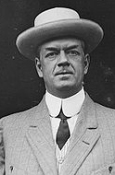
Postmaster General
Jan. 1 - Mar. 4: Frank H. Hitchcock
Mar. 5 - Dec. 31: Albert S. Burleson
Music
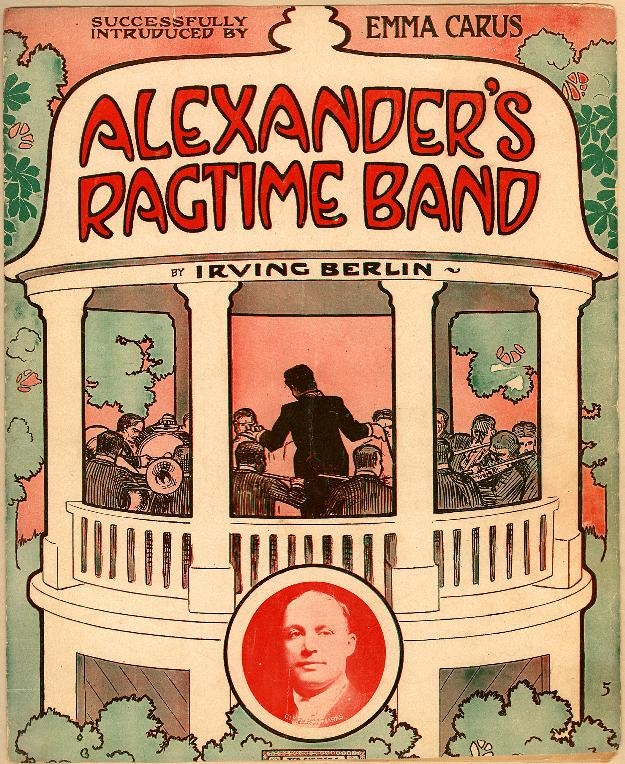
Click Control Above To Hear
1913 "Alexander's Ragtime Band Medley"
Postage Rates
Domestic Letter Rate: 2¢ per oz.
Postcard Rate: 1¢
Registry Fee: 10¢
Foreign Rate: 5¢
Stamps
The Panama-Pacific Exposition Issue - Perf 12 of 1913
Flat Plate - Perf 12 - Single-line Watermark - 280 Subject Plates

Vasco Nu ez de Balboa
First Day: 1/1/13
Est. 200 million issued

The Golden Gate at San Francisco
First Day: 1/1/13
Est. 15 million issued

Discovery of San Francisco Bay
First Day: Jan. 1, 1913
Est. 4 million issued

Gatun Locks at Panama Canal
First Day: Jan. 18, 1913
Est. 300 million issued
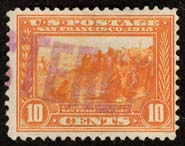
Discovery of San Francisco Bay
First Day: August 25, 1913,br>Est. 5 million issued
The Panama Pacific Exposition Stamps of 1913
Like most of the commemorative stamps that preceded them, the Panama Pacific commemoratives were issued to promote a current event, the Panama Pacific Exposition and World's Fair in San Francisco from February 20 to December 4, 1915. It may seem strange that stamps issued in 1913 would be inscribed "San Francisco, 1915", but the stamps were issued early to give advance notice of the event. San Francisco was not the only city interested in hosting the World's Fair, New Orleans was also considered. In the end, San Francisco benefited mightily from being the city chosen. Construction for the Fair began in 1911, just five years after the great earthquake of 1906, and the restoration of the city and indeed the glamour of the city to this day may be partly attributed to this event.
Although promoters had pushed for a large format for this stamp, as high as two inches, the size chosen proved more practical and the stamps were fairly well received by the public. The series was originally perforated 12 and an ample supply of this perforation were set aside by collectors. In late 1914 and early 1915, when the Post Office was experimenting with the 10 gauge perforation, the Panama Pacific stamps were also perforated 10. Neither the Post Office nor collectors of the time seemed to regard this as a new issue, and although printed in nearly equal amounts, the perf 10 Panama Pacific stamps are far rarer.
According to Johl, the perf 12 stamps were released to Post Offices in late 1912. However, First Day sales were to be held in San Francisco on January 1, 1913. Although First Day Covers are known from other cities, no covers are known before January 1, and all are extremely scarce.
The 1¢ Panama Pacific Stamp -Vasco Nu ez de Balboa Perf 12
Only two of the designs in this series commemorated historical events, the one cent stamp, the discoverer of the Pacific Ocean and the ten cent stamp, the discovery of San Francisco Bay. On September 1, 1513, Balboa departed with about ninety of his troops and Indian guides from the Atlantic port city of San Blas, in what is now Panama. Taking a generally southern route in search of a "great sea" the natives had talked about, they reached the southern shore of the isthmus on September 13, claiming the "South Sea" - what is now the Pacific Ocean - and all its adjacent lands for Spain.
This stamp commemorates the 400th anniversary of the year Balboa discovered the Pacific Ocean. It was issued in the green of the other 1¢ stamps of the era, resulting in one of the more attractive stamps of the set. Johl lists a wide variety of shades for the stamp, from yellowish to grayish to deep green. As mentioned above, First Day Covers of this stamp are very rare.
The 2¢ Panama Pacific Stamp - The Pedro Miguel Locks at Panama Canal Perf 12
You might have noticed that the two cent Panama Pacific stamp was not issued with the others in the set. This was because the original stamp bore the inscription "Gatun Locks", assuming that the engraving was of the locks connecting the Atlantic Ocean to Gatun Lake. When it was discovered that the photograph was of the Pedro Miguel locks, closer to the Pacific side of the Canal, the "Gatun Locks" stamps were recalled and destroyed. As far as we know, not one of these stamps has survived, although a few of the proofs from which they were made are known and are highly collectible.
By the time the stamp was redesigned and ready for production and delivery to Post Offices, it was more than two weeks after the other stamps in the set had already been issued.
The two cent stamp was issued in the red of the other 2¢ stamps of the era. There is a highly collectible dark shade of this stamp, carmine lake, of which, according to Johl, only 40 copies are known, all unused from the same partial pane of 70 issued to the San Francisco Post Office. Since the sheets were printed in sheets of 280 subjects, four panes of 70 stamps, it is probable that more "lake" 2¢ stamps exist. The carmine lake shade is scarce enough that certification is mandatory. Johl states that the color is similar to the shade of the Parcel Post stamps - see below - but we find the two cent lake stamp to be somewhat darker than the Parcel Post issues. The two cent stamp was issued in the red of the other 2¢ stamps of the era. There is a highly collectible dark shade of this stamp, carmine lake, of which, according to Johl, only 40 copies are known, all unused from the same partial pane of 70 issued to the San Francisco Post Office. Since the sheets were printed in sheets of 280 subjects, four panes of 70 stamps, it is probable that more "lake" 2¢ stamps exist. The carmine lake shade is scarce enough that certification is mandatory. Johl states that the color is similar to the shade of the Parcel Post stamps - see below - but we find the two cent lake stamp to be somewhat darker than the Parcel Post issues.
Interesting Fact: The entrance to the Panama Canal on the Atlantic side is actually west of the entrance to the canal on the Pacific side.
The 5¢ Panama Pacific Stamp - The Golden Gate at Sunset Perf 12
The straight at San Francisco is dominated today by the Golden Gate Bridge, but at the time the Panama Pacific stamps were issued the beauty of the intact harbor in the dark blue of the 5¢ stamps of the day proved most appealing. The stamp was designed by one of the Bureau's own, Clair Aubrey Huston, and is considered by many to be one of the finest engraved stamps ever produced by the U.S. The subject matter was so appealing in fact, that it was used again less than ten years later on the twenty cent ordinary stamp of the Series of 1922, although with nowhere near the effect of this stamp. Fifteen years later, with the completion of the Golden Gate Bridge in 1937, the bridgeless scene took on a new romance.
Since the 5¢ rate was primarily for foreign mail matter, early covers bearing this stamp are rare and First Day Covers are exceedingly rare. Even used stamps bearing the "International Exposition" cancels bring a premium.
The 10¢ Panama Pacific Stamp - The Discovery of San Francisco Perf 12
It may seem amazing, but the event depicted on the ten cent stamp happened in 1769, only a few years before the American War of Independence began. How a bay as large as San Francisco's had escaped discovery for so long is something of a puzzle. Added to that, the actual history of the discovery of the bay is somewhat muddled. Originally it had been thought that Sir Francis Drake had discovered the bay in his explorations of the West Coast in 1579, but it is now thought that his discovery was actually Drake's Bay, and the importance of the San Francisco harbor was completely overlooked for nearly two more centuries. In 1769, the Spanish explorer Gaspar de Portola led the first expedition to overlook the bay from land, the scene which we assume is portrayed by this stamp - Portola and his crew with the the Muwekma Ohlone natives - based on a painting by Charles Mathews, Discovery of San Francisco Bay. Even Portola did not recognize the importance of what he saw and it wasn't until 1775 that Juan Manuel de Ayala, the young Captain of the Spanish ship San Carlos, fully realized the importance of this hidden port and thus began the first settlements in the Bay area.
This stamp was issued in the customary yellow of the 10¢ stamps of the day, but the design showed so poorly, that by August of that year a darker shade was implemented, the orange Number 400A. Since the Post Office did not regard the change in shade as a new variety, collectors did not put as many of these stamps aside as they had the yellow ones, and the orange stamps bring a small premium today.
The Parcel Post Stamps First Issued in 1913
Flat Plate - Perf 12 - Single-line Watermark - 180 Subject Plates
See 1912 for additional issues
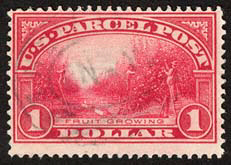
$1 Fruit Growing
1,053,273 million issued
Issued: Jan. 3, 1913
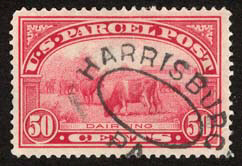
50¢ Dairying in America
2,117,793 million issued
Issued: March 13, 1913
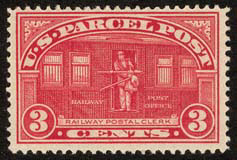
3¢ Railway Postal Clerk
29,027,433 million issued
Issued: April 5, 1913
Initial designs of the one dollar and the fifty cent Parcel Post stamps were of an industrial steel mill, a design which was used on the 25¢ stamp. Design changes reflected important industries in other parts of America, fruit growing in the West and dairy farming in the Midwest. The 3¢ stamp was held up when it was felt the original design, showing a postal truck delivering mail to the railcar, did not fully reflect the importance of the postal worker, something the other lower values portrayed, and a larger figure of the handler replaced the original design.
The Parcel Postage stamp experiment had a very short lifespan. The law mandating the use of a special Parcel Postage stamp on all parcels went into effect January 1, 1913. Six months later the law was rescinded, allowing the usage of regular postage stamps to pay the parcel fee.
see also: Parcel Post Stamps Issued in 1912
The following postage stamp varieties were first issued by the U.S. in 1913:
No new varieties of U.S. Postage Due stamps were issued in 1913
No new varieties of U.S. Special Delivery stamps were issued in 1913
Ordinary issue:
Number 396 - 5¢ Washington perf 8½ vertically - EDU: 5/5/13 to Lyon, France
Number 424d - 1¢ Washington perf 10 watermarked Booklet (pane) - EDU: 12/18/13
Commemoratives:
Flat Plate - Perf 12 - Designer: C. Aubrey Huston
Number 397 - 1¢ Panama Pacific Exposition - Engraver: J. Eissler
Number 398 - 2¢ Panama Pacific Exposition - Engraver: Marcus Baldwin
Number 399 - 5¢ Panama Pacific Exposition - Engraver: L. C. Schofield
Number 400 - 10¢ Panama Pacific Exposition Yellow - Engraver: Marcus Baldwin
Number 400A - 10¢ Panama Pacific Exposition Orange Red
Parcel Post:
Flat Plate - Perf 12 - Designer: C. Aubrey Huston
First Day Covers - July 1, 1913 (after the issue was discontinued and became valid for general postage)
Number Q3 - 3¢ Railway Postal Clerk - Engravers: H. Charlton, Joachim Benzing and Edward M. Hall
Number Q10 - 50¢ Dairying - Engravers: Marcus W. Baldwin, Edward M. Hall
Number Q12 - $1 Fruit Growing - Engravers: M. W. Baldwin, E. M. Hall, C. M. Chalmers, E. Myers and F. Lamasure





